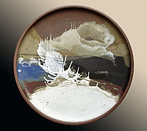
Studio S
P O T T E R Y
WELCOME!
Scroll Down For Additional Information
Former art professor does work for Washington
by Phyllis Skipper
MTSU Sidelines


Mrs. Jimmy Carter broke the rules. When she gave her luncheon for all the senators' wives back in May, she did a unique thing. Instead of using formal, dainty white china (which had tradi-tionally been used), she hired ten potters from across the nation to do a 12-place setting each of pottery-work china. A majority of the potters commissioned to produce the china were from the New England states. However, one of the potters was from Murfreesboro.
Lewis Snyder, a former associate professor in ceramics at MTSU, was called upon by Mrs. Carter to create one of the 12-place dinner settings. "I took three or four pieces of my work to Washington and was told to suit myself," Snyder said, 'Which is what I would have done anyway," he quipped.
The first lady arranged 10 tables at the luncheon with each potter's work displayed separately. Another table displayed one place setting from each pottery set.
Mrs. Carter, like many other American people is realizing you don't have to have fine china for a pretty table. Speaking at the White House luncheon, Mrs. Carter coined one of Snyder's phrases, "crafts are the people's art."
Snyder had four weeks to finish the china, "which is really rather fast for us."
"Us" is Snyder and his employees. He has two employees working for him this summer in his studio. One of them is his eldest son Lewis Paul, a pre-law major at UT, the other Robert Alewine from West Tennessee.
Snyder came to MTSU in 1962 from West Virginia. He took a two-year leave of absence from the university when the state governor appointed him to the Tennessee Arts Commission. Snyder "decided to stay on with the commission" and left MTSU in 1972 after having built up a fine crafts program with the arts department.
Today, Snyder works out of the "Studio S" at 1426 Avon Dr. The facility is a renovated cow barn which Snyder's family turned into a most impressive working studio.
It sits behind the Snyder home and is open to anyone who wishes to come and browse from 9 a.m. to 5 p.m. Monday through Saturday and 1 to 5 p.m. on Sunday.
But you won't be able to resist buying something, and Snyder places very inexpensive prices on his work.
The White House china is on display in the studio, and reproductions are for sale.
The studio is Snyder's working place and selling place. He offers pottery classes on Thursday nights from 7 to 9:30. Cost of the classes is $55 for 10 weeks and includes all materials.
Snyder's operation is unique in that he makes his own clay and glazes.
Helpers are never in demand because "They come to us," claims his wife Wilda, business manager for the operation. Snyder has hired some MTSU students, but he adds, "We have had quite a few people working for us that have come from Illinois."
Snyder says that he has been involved in almost every craft project in the Southeast. He has had teaching experience at nine institutions, he has done extensive research in the field of pottery and has conducted numerous exhibitions all over the United States.
Snyder is a member of 11 professional organizations including the national Association of Handcraftsmen, Inc., of which he is president. He has served as president of two other professional organizations and is listed among Who's Who in America--South and Southeast. His works appear in 35 permanent collections. Snyder has written numerous magazine articles on the crafts movement or some aspect of it.
Place settings of the white House china are being shown in the Renwick Gallery, part of the Smithsonian Institute; the Museum of Contemporary Crafts in New York, the Museum of Crafts and Folk Art in California and a museum in Wisconsin.
Snyder's whole family is involved in the business in some way. His wife works the business end while Snyder and his oldest son produced the pottery. Snyder's uncle, Aaron, has a display of woodworks in the gallery and Snyder's youngest son, Eric, 11 has some sculpture pieces displayed. Snyder claims his works are better known for the quality of the glaze. It took him seven years to develop a crystalline glaze, "which is the hardest to make." Snyder has developed a total of 25 glazes.
He sells to regular collectors that come from the surrounding area and from as far as Huntsville, Ala. He sells much of his work at craft shows, but he does very little wholesaling, because "there's not much money in wholesale."
However, he does occasionally sell work to a shop in Gatlinburg and one in Oak Ridge.

Lewis & Eric Snyder